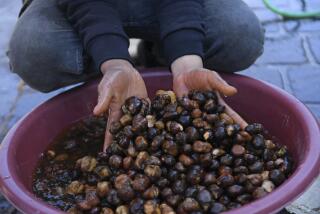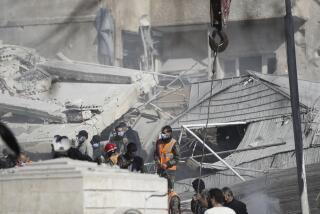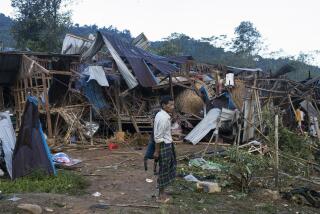Deal reached to evacuate civilians trapped in Syrian city of Homs

DAMASCUS, Syria -- An agreement has been reached to evacuate civilians trapped in the battle-scarred remnants of the Old City of Homs, Syria’s third-largest city, the state news agency reported Thursday.
The accord would also allow the delivery of “humanitarian assistance and supplies to the civilians who would choose to stay inside the city,” according to the official Syrian Arab News Agency.
The plight of people trapped in Old Homs drew international attention last month when negotiators at Syrian peace talks in Geneva said officials had arranged to evacuate civilians and deliver humanitarian aid.
However, that prospective deal fell apart amid deep distrust between the government and a holdout force of rebels who are bunkered down inside Old Homs.
Between 1,500 and 2,000 civilians are believed to be in the heavily damaged old quarter of Homs, which is surrounded by forces loyal to the government of President Bashar Assad. Food and other staples are reported to be in short supply. How many fighters remain is unclear.
On Thursday, Syria’s state news bureau reported that Homs Gov. Talas Barazi and the United Nations had reached the humanitarian accord. The deal “gives the innocent civilians besieged in the neighborhoods of the old city of Homs, including children, women, the injured and elderly people, the chance to leave the city as soon as necessary arrangements are secured,” the official news agency reported, citing a Foreign Ministry statement.
U.N. and other officials were reportedly headed to Homs late Thursday in anticipation that some residents could be brought out as soon as Friday.
There was no immediate reaction from opposition forces inside Homs. A rebel group had previously demanded large-scale aid deliveries into the Old City and safe passage for civilians to another opposition-dominated district.
The civilians inside Old Homs have been marooned there for more than a year. Their plight was little noticed by the outside world as other aspects of Syria’s civil war took precedence and the focus shifted from Homs, long a flash point in Syria’s almost 3-year-old conflict. Little aid has trickled in, and the humanitarian scenario is said to be dire.
But the Geneva talks cast a global spotlight on the predicament of Old Homs’ remnant population and that of more than 250,000 Syrians nationwide said to be trapped in communities blockaded by one side or another, lacking food and other essentials.
In the case of Homs, government officials and opposition spokesmen have traded blame for the humanitarian crisis.
Syrian officials say most civilians inside the Old City are being held against their will as “human shields,” their presence meant to discourage government bombardment. The opposition asserts that people are afraid to leave because they could face detention or death in government hands.
The government says it is willing to allow aid convoys for civilians but not for “terrorists,” its term for anti-government rebels. The opposition accuses Damascus of being engaged in a “starve or submit” campaign in Homs and elsewhere.
But international calls have mounted for all sides in the conflict to reach an accord that would allow aid to reach besieged areas while permitting trapped residents to exit blockaded zones if they choose to leave.
[Updated at 12:38 p.m. PST on Feb. 6: Meanwhile, rebels and the government reported renewed conflict at the central prison in Aleppo, but officials denied opposition assertions that hundreds of prisoners had been freed. The prison has been the site of combat between troops and rebels for months.]
Twitter: @mcdneville
Special correspondent Nabih Bulos contributed to this report.
More to Read
Start your day right
Sign up for Essential California for news, features and recommendations from the L.A. Times and beyond in your inbox six days a week.
You may occasionally receive promotional content from the Los Angeles Times.






